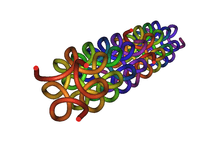Collagen helix
| Collagen triple helix | |||||||||
|---|---|---|---|---|---|---|---|---|---|
 Model of a collagen helix.[1] | |||||||||
| Identifiers | |||||||||
| Symbol | Collagen | ||||||||
| Pfam | PF01391 | ||||||||
| InterPro | IPR008160 | ||||||||
| SCOP | 1a9a | ||||||||
| SUPERFAMILY | 1a9a | ||||||||
| |||||||||

In collagen, the collagen helix, or type-2 helix, is a major shape in secondary structure. It consists of a triple helix made of the repetitious amino acid sequence glycine - X - Y, where X and Y are frequently proline or hydroxyproline.[2][3] Each of the three chains is stabilized by the steric repulsion due to the pyrrolidine rings of proline and hydroxyproline residues. The pyrrolidine rings keep out of each other’s way when the polypeptide chain assumes this extended helical form, which is much more open than the tightly coiled form of the alpha helix. The three chains are hydrogen bonded to each other. The hydrogen bond donors are the peptide NH groups of glycine residues. The hydrogen bond acceptors are the CO groups of residues on the other chains. The OH group of hydroxyproline also participates in hydrogen bonding. The rise of the collagen helix (superhelix) is 2.9 Å (0.29 nm) per residue.
References
- ↑ Berisio R, Vitagliano L, Mazzarella L, Zagari A (February 2002). "Crystal structure of the collagen triple helix model [(Pro-Pro-Gly)(10)](3)". Protein Sci. 11 (2): 262–70. doi:10.1110/ps.32602. PMC 2373432
 . PMID 11790836.
. PMID 11790836. - ↑ Bhattacharjee A, Bansal M (March 2005). "Collagen structure: the Madras triple helix and the current scenario". IUBMB Life. 57 (3): 161–72. doi:10.1080/15216540500090710. PMID 16036578.
- ↑ Saad, Mohamed (Oct 1994). Low resolution structure and packing investigations of collagen crystalline domains in tendon using Synchrotron Radiation X-rays, Structure factors determination, evaluation of Isomorphous Replacement methods and other modeling. PhD Thesis, Université Joseph Fourier Grenoble I. pp. 1–221. doi:10.13140/2.1.4776.7844.